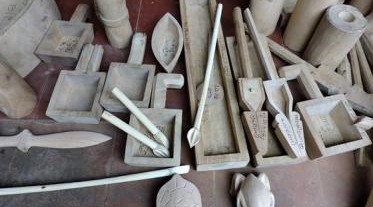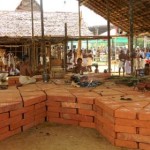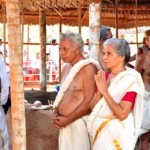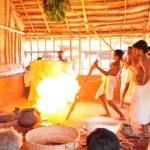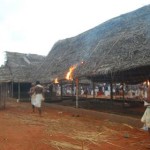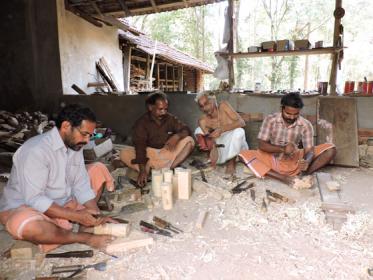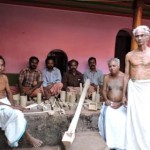The Vedic Ritual Sagnikam Athirathram Back
Sukapuram gramam, an ancient village in Kerala (India) famous for its Vedic practitioners are hosting the Vedic ritual Sagnikam Athirathram from 20-31 March 2015. Vedic tradition of Kerala has been noticed worldwide since long back as an oral tradition with systematic way of chanting the Manthras and the strict format of ritual performances. Recently UNESCO has recognised Kerala tradition of recital and chanting as an oral and intangible heritage of mankind.
Sukapuram gramam, an ancient village in Kerala famous for its Vedic practitioners, is hosting the Vedic ritual Sagnikam Athirathram during the end of the month March. This Yagam or Yagna is considered as the practical application of Vedas, the ancient text of India. According to belief, Yagams are performed for the well being of mankind and nature. Yagams are the most significant and important Vedic rituals being practiced by the Brahmin community of India since ancient times.
Among the different kinds of Yagam-s, Agnishtomam and Sagnikam Athirathram are the two types of Yagams practiced by the Nambuthiris, the Brahmin community of Kerala. Vedic tradition of Kerala has been noticed worldwide since long back as an oral tradition with systematic way of chanting the Manthras and the strict format of ritual performances. Recently UNESCO has recognised Kerala tradition of recital and chanting as an oral and intangible heritage of mankind.
The Ritual
The person who conducts, controls and guides the Yagam is called Yajamanan. He should be married and his wife should also take part in the rituals. She is addressed as Yajamana Pathni. Only a person who has conducted Agnishtomams earlier can be a Yajamanan for a Sagnikam Athirathram. According to the Nambuthiri custom the one who conducts Agnishtomam is honoured with the title Somayajippad and after the completion of Athirathram he is bestowed with the title Akkithirippadu. He dedicates the Yagam to mankind without selfishness and is elevated to a higher spiritual level during and after the Yagam. There are seventeen individuals called Rithwik-s, to assist the Yajamanan during Yagam. The main Rithwiks are called Adharyu, Hothan, Udgathan and Brahman, who are specialised in the four Vedas Yajur, Rik, Samam and Adharvam respectively.
The duration of an Agnishtomam is six days and that of a Sagnikam Athirathram is 12 days. Yagam is performed in specially constructed thatched shed called Yagasala. All the measurements of Yagasaala are calculated in relation to height of the Yajamanan. The holy fire place Chithi, work area the rest rooms and others are all in the Yagasala.
Chithi is the main fire place, which is constructed using big bricks specially made for this purpose. According to the shape, the Chithi-s are differentiated and the one used in Kerala for Agnikam Athirathram is called Garuda Chithi, which is quite large and shaped like an eagle. Over 1000 bricks are used to construct the five –layered Chithi.
The most important offering is to the fire (the process of offering to the fire is called Homam) is Somarasam, the juice from Somalatha, a creeper plant (Sarcostemma ascidium). These plants are usually available in the Western Ghats and by tradition; the right to supply this plants is vested on the Raja of Kollankode in Palakkad district.
Most of the rituals performed during the first nine days of Yagam are preparatory, to enable the Yajamanan to perform the Homam and the Chithi to accept it. The first three days in Athirathram are called Deeksha hassukkal and these days are mainly for preparations like Deeksha Varikkal (Yajamanan preparing himself for the Yagam) , assigning all the Rithwiks, ceremonial construction of the Yagasala, (called Vedikaranam) etc. The next six days are called Upasad Dinangal. The first layer of Chithi is constructed on the fourth day and construction of Chithi is completed by the eighth day i.e. by adding a layer every day. All these are ritualistic performances accompanied by the chanting of Manthras.
Another important ritual performed during these days is called Pravargyam. In this ritual, ghee is boiled in a specially made mud pot named Mahaveeram, followed by chanting of manthras. And simultaneously, milk of the cow and goat is poured into it, resulting in fire balls, shooting up from the pot. The belief is that this ritual will strengthen the mental power of Yajamanan to perform the Homam.
On the ninth day, the holy fire is set on the Chithi and rituals are performed to enable the Chithi to conceive the main offering Somarasam. The tenth day heralds the beginning of the important functions and continues through day and night till the end of twelfth day. After Somahuthi, the homam of Somarasam, Kalpa- prayaschitham is performed. This is to overcome any imperfections and mistakes in the Yaagam. Then is Avabhrutham Ishtti, in which most of the used items are deposited in a water body and everyone takes a dip in it. The holy fire is taken to Yajamanan’s home and the Yagasalasala is set to fire.
Even after the Yagam is over the Yajamanan with his wife have to maintain the holy fire with great sanctity. This fire is kept alive at their home using rice husk and coconut shell and every day the Yajamanan has to offer some homam to the fire. This will continue till the death of either of them. Then this fire is taken for the cremation of the deceased. So his whole life is dedicated to the wellbeing of the world and through this he achieves Moksha, assimilation with eternity.
Preparations:
The traditional Nambuthiri home, Narayanamangalathu Mana (shortly called Naaras Mana) is the epicentre for all the preparations. Under the supervision of Dr. Naaras Itty Ravi Nambuthiri the training on the chanting of Manthras is going on. He also gives guidance to the traditional carpenter from Ottappalam, Kottapparambil Radhakrishnan Asari and his three brothers for making of wide variety of wooden pots, vessels and other implements required for Yagam. The bricks for Chithi are under construction at Malabar tiles Factory at Feroke. The Yagasala also started constructing at the venue, near Sukapuram temple.
Performers:
Yajamanan- Panamanna Kavumpurathu Vasudevan Somayajippadu
Yajamana Pathni- Gouri Pathanaadi
(Yajamanan for Somayagam 2013, at same place)
Adharyu (Yajur)- Kadaloor Narayanan Nambuthiri
Howthram( Rik)- Kavupramarath Sankaranarayanan Nambuthiri
Brahman (Adharvam)- Kadaloor Sreenath
Udgaadan (Samam)- Thottam Sivakaran Nambuthiri
Others: Dr. Naaras Itty Ravi Nambuthiri , Cherumukku Vallabhan Nambuthiri, Erkkara Brahmadathan Nambuthiri, Cherumukku Appu Nambuthiri, Erkkara Sankaran Nambuthiri, Sathish Deshmukh (Maharastra), Naddam Bhavathrathan Nambuthiri etc.
Organisers:
Inspired by the successful completion of Agnishtomam that was held in 2013 at Sukapuram, the people of Sukapuram and neighbouring villages came forward to conduct Athirathram 2015, which was initially supposed to be conducted at New Delhi. A common place near Sukapuram Dakshinamoorthy temple will be the venue for this Yagam. A public committee called Yajna Nirvahana Samithi is being constituted for the smooth running of Athirathram under the patronage of Chennas Dineshan Nambuthirippadu, the Chief priest at Guruvayur temple, Jathavethan Nambuthiri and Sreemoolanagaram Narayanankutty. The committee, which include representatives from all political parties, local Panchayaths, religious and cultural organisations is headed by Dr. K V Krishnan (President), Kurungaattu Vasudevan Nambuthiri (General Secretary), Dr. K M J Nambuthiri (General Convener) and Viswanathan (Treasurer).
Location/access:
The venue is Near Sukapuram Dakshinamoorthy Temple, Edappal, Malappuram Dt, Kerala (India). Edappal is a main town on Kozhikode-Thrissur main road. Nearest Railway station Kuttippuram is 10km away.
For info/visit:
President- Dr. Sir. K V Krishnan (Malabar Tiles, Feroke)
General Convener- Dr. K M J Nambuthiri
General Secretary- Kurungaattu Vasudevan Nambuthiri, Mob: +91- 9447437685
www.sukapuramathirathram.com
Article and Images Source: http://www.welcomekeralaonline.com/



